Butterflies have captured our imaginations for as long as can be remembered. Their delicate beauty, incredible life cycle and magnificent colors make them the source of much symbolism, imagery, folklore, and legend, earning them the right to be referred to as the ‘feel good ambassadors of the invertebrate world.’ They have been around for over 40 million years and as ambassadors we have much to learn from them. There’s no debating their magnificence; but why are butterflies important?

The restoration of Grace Farms’ meadows and other habitats has attracted pollinators and other wildlife that are essentials to our well-being and biodiversity. Photo by Julien Jarry
August Is Butterfly Month at Grace Farms
We are celebrating butterflies during the month of August, inviting visitors from all ages and backgrounds to learn more about this wonder of nature. As part of our nature-based programs, I hope you join me on August 24 for Nature’s Classroom, our new monthly series that invites hands-on and seasonal explorations of Grace Farms. We’ll be exploring nature’s gift of butterflies and moths, how and where they spend their lives, and all the ways you can create more habitats for these incredible pollinators in your own yard or community.
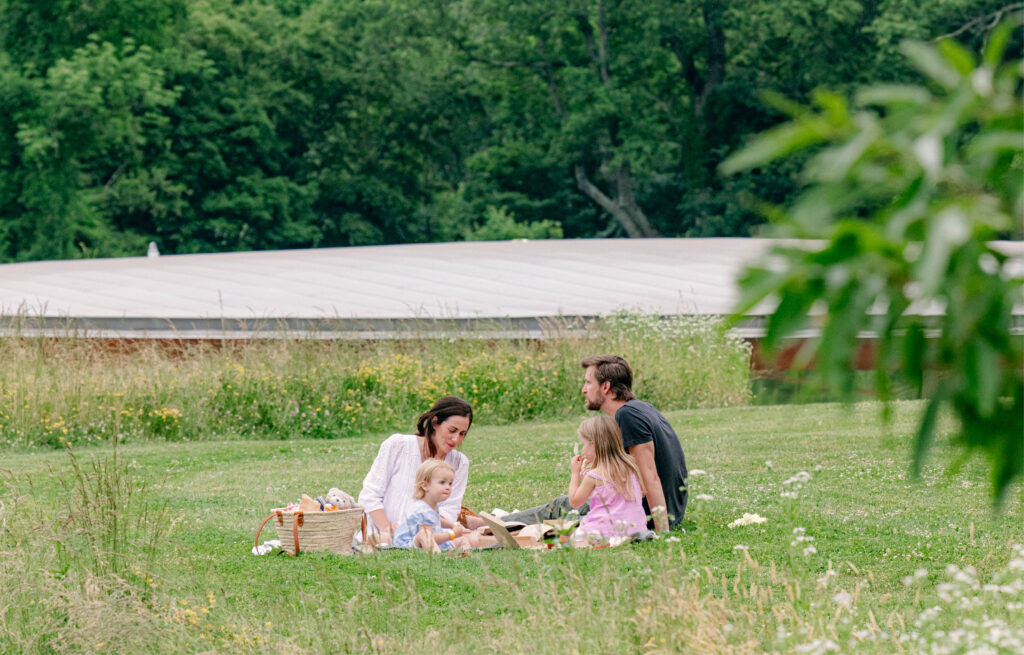
Meadows and nature surround Grace Farms’ award-winning River building in the background. Besides offering programs that explore nature, visitors often come to have a picnic with friends and family.
Their delicate beauty, incredible life cycle and magnificent colors make them the source of much symbolism, imagery, folklore, and legend …
These wonders of nature are gifts that keeps on giving. Merriam-Webster defines a gift as ‘something voluntarily transferred by one person to another without compensation.’ Well, if that isn’t somewhat limiting… I am not sure what is. What about the gifts we receive every day from the world that sustains us? Who can sit and watch a hummingbird glide from one flower to another glowing in the sun and not say a little ‘thank you’? How about watching dragonflies hover and dart about?
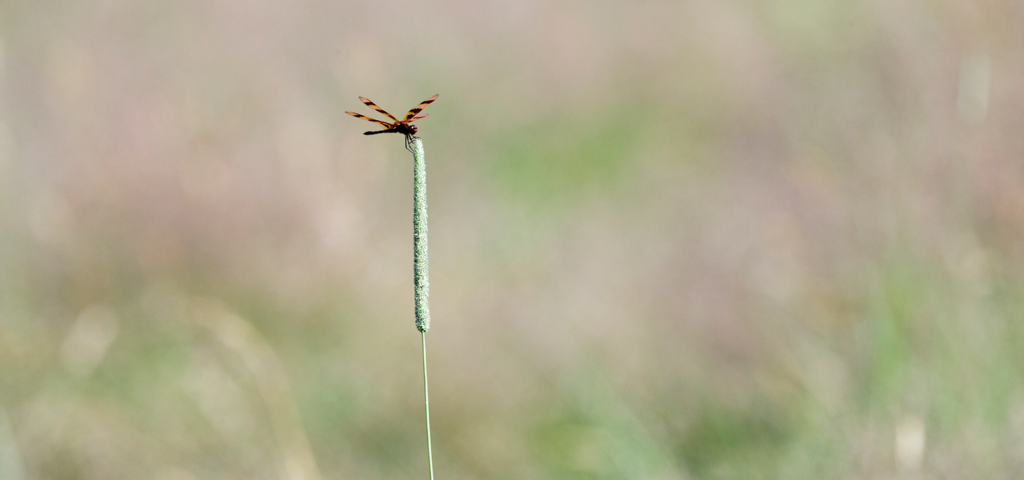
A dragonfly momentarily pauses in our meadows during its acrobatic dance.
Or the magic of the butterflies as they dance in the air only to land on a beautiful flower nearby? Each one of these experiences is a gift in its own way, no strings attached and no return address. What if those simple gifts started to dwindle, how and who would it impact? Why is it even important?

Kimberly Kelly, left, talking to children about some of the wonders of nature. Photo by Kyle Norton
But why are butterflies important? | An Indicator Species
Butterflies can detect changes in nature before we do because they are very sensitive to changes in their surroundings. That’s why they are an important “indicator species,” detecting environmental changes that we may not see right away. A shift in butterfly numbers or species composition in a particular area can signal significant change of a habitat’s quality. Many butterfly species around the world are in decline, and others have already gone extinct. The biggest overall threat to them is habitat loss, deforestation, agriculture, urbanization, introduced non-native species, global climate change, and pollution. These are just some of the factors contributing to the degradation or destruction of butterfly habitats.
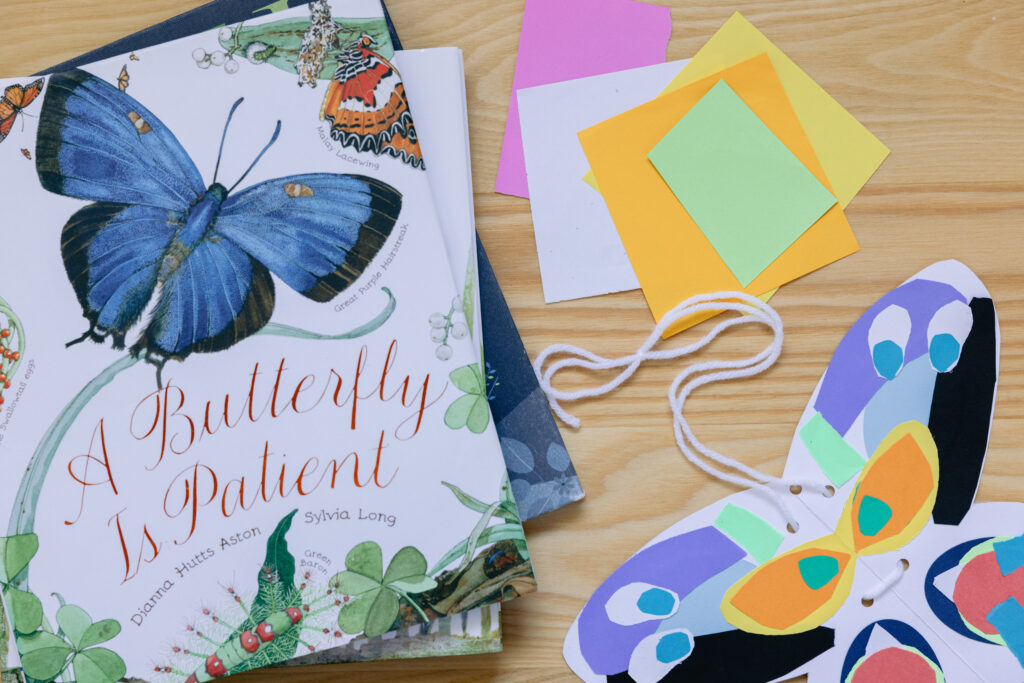
Throughout the year we offer educational nature programing for people from all backgrounds and ages. Books in our Library offer an opportunity to learn more about nature and other initiatives. Photo by Jack Dolata
A shift in butterfly numbers or species composition in a particular area can signal significant change of a habitat’s quality.
When we think of butterfly habitats, we often think what varieties of pollinator plants we can add to our gardens. That’s a wonderful start, but remember, the adult butterfly is just a small portion of the complete life of the butterfly. With their fascinating life cycle of complete metamorphosis, have you ever considered where the caterpillars are coming from, what they are eating, and how big a role they play in the food chain? Talk about the unsung heroes of the butterfly world!
Throughout our nearly 80 acres of 10 biodiverse habitats at Grace Farms, we look for holes in the leaves with great anticipation and are thrilled when we find a caterpillar munching away. If there are hungry caterpillars, they will produce many butterflies. The caterpillars also serve as food for the birds, part of a healthy ecological cycle.
Supporting Butterflies
Unlike the Monarchs (Danaus plexippus) that utilize the milkweed plants (Asclepias spp.) for both their larval and nectar host, most butterflies lay their eggs on a different plant. Two-thirds of butterfly species feed on a single plant family, and one-third are considered generalists. This means that they will lay their eggs on only one type of plant to ensure caterpillars have the right food to eat. This process has evolved over a long period of time and is referred to as coevolution.
Two-thirds of butterfly species feed on a single plant family, and one-third are considered generalists.
Many butterflies rely on trees as a larval host. Here are useful references from the Connecticut Association of Conservation Districts (ConserveCT.org) and the National Audubon Society to some of the most common host plants in Connecticut.
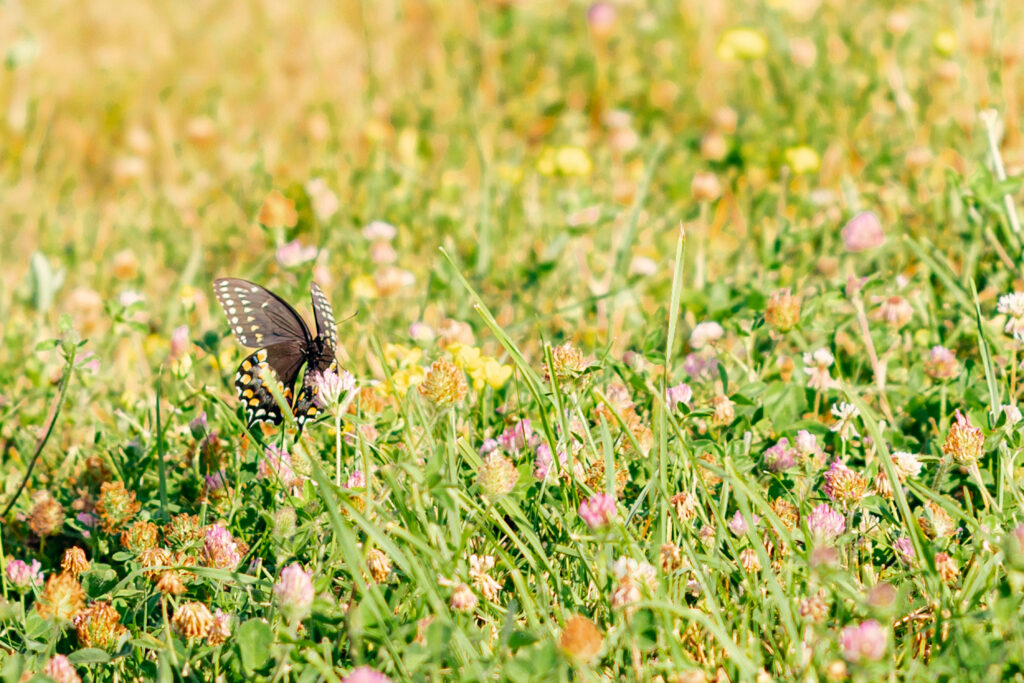
Over the years we have installed thousands of native plants to support our essential pollinators including butterflies, bees, and birds. Photo by Melani Lust
You’ll notice from these resources the inclusion of native plants. That’s good news because native plants are gaining in popularity. Thanks to educational programs at Grace Farms, and elsewhere, the public is learning about the importance of native plants. As a result, people are adding pollinator gardens to their home landscapes and to their community spaces. An important question to consider when selecting natives is: What plants are feeding the caterpillars? Planting for caterpillars, however, does mean tolerating some devoured leaves. For many species of butterflies, trees and shrubs are the larval host plants. This means that we may need to look not only at the practices on our own property but those in our communities as well.
At Grace Farms, we are working to enhance and restore natural habitats by planting not only nectar plants but the larval host plants as well. This effort has already produced amazing results. It is our way of saying ‘thank you’ for such a precious gift – a gift that truly keeps on giving!
So come and help us celebrate the gift of butterflies and moths (Lepidoptera family) for the entire month of August with daily programs and awe-inspiring nature walks.
By Kimberly Kelly, Director of Horticulture
________________________
Kimberly Kelly brings over 25 years of experience to Grace Farms. During her career, she has fostered inclusive and meaningful ways to connect the public to the natural world, through horticulture, ecology, and regenerative land-use practices using both formal and informal educational programs.
Kimberly currently serves as member of the Board of Directors of the Connecticut Master Gardener Association and is the President of the Board of Director of the International Association of Butterfly Exhibitors and Suppliers. Learn more.
________________________
About Grace Farms
Grace Farms is a center for culture and collaboration in New Canaan, Connecticut. We bring together people across sectors to explore nature, arts, justice, community, and faith at the SANAA-designed River building and Barns on 80 acres of publicly accessible, preserved natural landscape. Our humanitarian work to end modern slavery and foster more grace and peace in our local and global community includes leading the Design for Freedom movement to eliminate forced labor in the building materials supply chain.
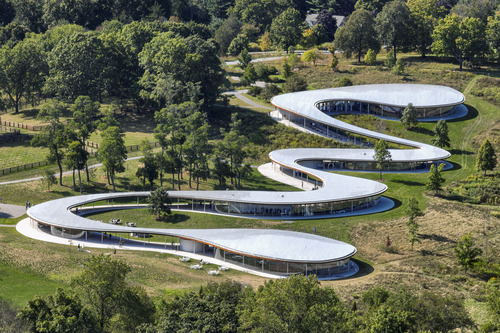
The SANAA-designed River building is embedded in 80 acres of natural landscape. Grace Farms is free and open to the public six days a week, other than Monday. Photo by Kyle Norton
Become a member
Grace Farms members enjoy special access to member-only events, experiential activities, and thought-provoking programs — and the opportunity to be a part of our mission to pursue a more peaceful world.
Learn more at gracefarms.org/membership
Visit our calendar of events to learn more about upcoming programs.
Sign-up for our newsletter
Follow us
@gracefarmsct #gracefarms

